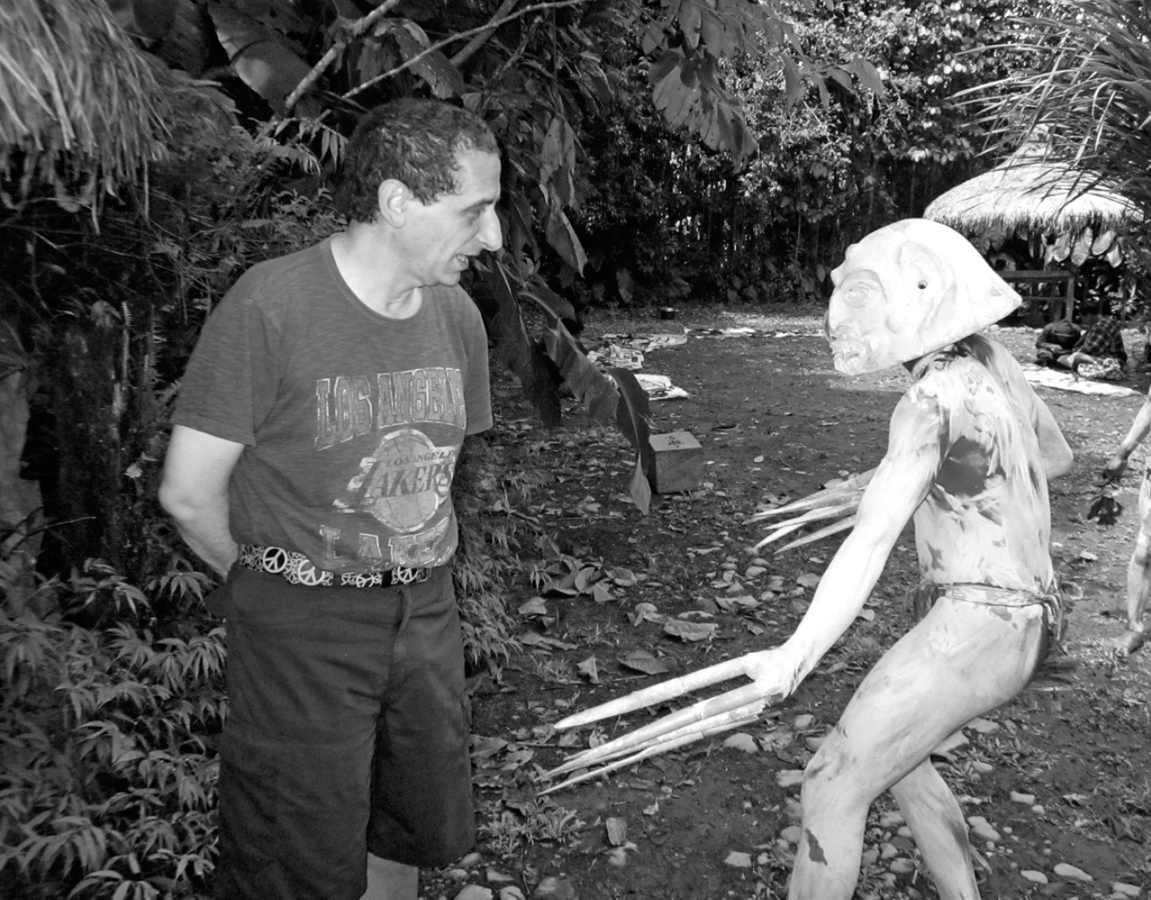Seeing the World with The Simpsons
I’ve visited 113 countries. Not by choice. My travel tastes range from Disneyland to Disneyworld.
But my wife loves to travel. We’ve been to the North Pole and the South Pole—if they ever find an East Pole, I’m sure we’ll be going there. My wife has even dragged her clearly Semitic husband to every Jew-hating place on earth: Iran, Iraq, Syria, South Carolina. So why do I go? Because I fear my wife more than I fear ISIS.
I’m always on the move—portions of the book you’re holding were written in Kazakhstan, Uzbekistan, Egypt, Japan, and Epcot Center; I’m typing this sentence in a Sudanese city called “Wow!” You may travel to forget about work, but I don’t have that luxury because people watch The Simpsons everywhere. This hit me on our first day in Iran. My tour guide asked me what I did for a living. How could I explain our show to a young man who’d never left Tehran? Do they have cartoons in Iran?
I began, “I write for this show called The Simpsons . . .”
“You know, I really liked the early seasons,” he replied. “But even a bad Simpsons is better than a good Family Guy.”
I thought about adopting him.
The Simpsons is the only thing Israelis and Egyptians agree on. In Iraq, fighting stopped from five to six every day so they could watch back-to-back episodes. If the show ran twenty-fours a day, we could bring peace to that land.
In Kurdistan, our guide Rebwar kept muttering, in a pretty good Julie Kavner impression, “Oh, I love my Homie.”
In Singapore, I gave a speech and was mobbed by fans. Young women tore at my clothes and hair like I was Justin Bieber. It was horrifying, and I can’t wait to go back.
I was in a restaurant in Malaysia when the waiter told me, “Homer Simpson is a very Malaysian father.” Five minutes later, a Danish tourist said, “The Simpsons have a very Danish sense of humor.” The Danish have a sense of humor?
Australians, Canadians, Indians, and Brits are crazy for the show. But nobody loves it like South Americans. They see the show dubbed into Spanish by a Mexican cast, and many of them believe The Simpsons is a show about a Mexican family. Our Mexican cast members used to earn only thirty dollars a week, except for Homer, who got forty dollars because he owns the microphone. (I’m not being racist—these are the facts!) Finally, our Mexican cast went on strike—not for more money, but for more dignity. And I thought, You’re the Mexican Homer Simpson! How much dignity do you expect? (Okay, maybe now I’m being racist.)
In 1990, when the show was being translated for foreign markets, we did something most shows wouldn’t go to the trouble of doing: we sent our writer, Jay Kogen, around the world, to supervise the voice casting. Jay did a remarkable job: the French voices for Marge and Homer fell in love and got married in 2001. If you ever wondered, Would a woman like Marge ever marry a guy like Homer? you only have to meet this couple. They’re just like their characters: the wife is tall and prim, the husband squat and blunt. And like their characters, they seem crazy in love. L’amour!
People in every country tell me their Simpsons voices are better than ours—even the Czech Republic, where Marge is voiced by a man. And in Finland, I learned that children teach themselves to read just by watching The Simpsons—the show is in English there, with Finnish subtitles.
If you’re wondering how these countries manage to translate our puns and wordplay, the answer is: They don’t! All our clever sign jokes are left in English, with no translation. In Japan, when Bart called Moe’s Tavern, saying, “I’d like to speak to Mr. Coholic, first name Al,” it was translated as, “I’m looking for a very drunken man.” By my estimate, about one-third of our jokes are lost in translation. It doesn’t matter—the two-thirds that foreigners get, they really, really like.
If you work in television, every time you see a TV—in a store, through someone’s window—you hope they’re watching your show. In Bolivia, that really happened: as wizened old Mayan women were weaving baskets, they watched our show on tiny black-and-white TVs. In fact, there were actually riots in Bolivia when they cut Simpsons reruns back from four a day to three. (EDITOR: Did this really happen? ME: Yes!) During my trip there, my Bolivian tour guide brought me to his home, a one-room flat with a family of five stuffed into two beds. They didn’t have a kitchen. They didn’t have a bathroom. But they had every piece of Simpsons merchandise I’d ever seen. Simpsons posters lined the walls; Simpsons glasses filled the cupboards. Matt Groening is rich because this guy is broke.
But our tour guide in Colombia may be the biggest Simpsons fan on earth. When he found out who I was, he bombarded me with Simpsons trivia questions for the next three days—apparently one joke that just didn’t translate into Spanish was Homer’s line about possums: “I call the big one Bitey.”
Japan is the one big market The Simpsons can’t crack. Apparently, the Japanese don’t like the fact that the cartoon characters have four fingers—Disney actually goes to the expense of animating a fifth finger onto Mickey Mouse.
What bothers the Japanese about four fingers? You won’t believe the reason: Yakuza members swear loyalty by amputating their pinkies, so having four fingers implies you’re in the Japanese Mafia. Basically, the Japanese can’t tell the Simpsons from the Sopranos. I spent weeks in Japan without seeing the show anywhere. I started to miss it. Finally, I told my tour guide I wrote for The Simpsons. His eyes lit up. “Really? That show is still on?”
“Yes, it is—thirty years!” I crowed.
“Wow—I can’t believe I meet a man who writes The Flintstones!”
“Not The Flintstones, The Simpsons.”
He looked puzzled. “You call it Simpstones?”
“No. Simpsons!”
“Flimpsons?”
I gave up. “Yes. I write the Flimpsons.”
“Never heard of it.”
While almost every country loved our show, the French hated it. Why? Because the French suck. Seriously, our first season we did an episode where Bart went to France . . . and the French pulled our show off the air for seventeen years. (The show has since returned, and the French now love it.)
This experience taught me something key about The Simpsons—Americans look at Homer Simpson and go, “That’s my dad,” while foreigners look at Homer Simpson and go, “That’s an American.” In fact, the nation of Venezuela canceled their run of the show because “it promotes bad American values.” They pulled us off the air . . . and replaced us with Baywatch. (EDITOR: Did this really—ME: Yes, dammit!)
Nations who love the show suddenly don’t find it funny when the Simpson family visits their country. Famously, after the Simpsons went to Rio, the city’s tourism board threatened to sue us. Their complaint read something like, “When the Simpsons came to Rio, they encountered pickpockets, kidnappers, rat-infested slums, and wild monkeys. There are no wild monkeys in Rio.” I later visited Rio and saw hundreds of wild monkeys there. I also got robbed twice within four hours of arriving. The second robbery occurred forty feet from a cop who was sunning himself on the hood of his police car. He chose not to get involved. (EDITOR: Did—ME: YES, YES, AND YES!)
The weirdest reaction came after the Simpsons visited Canada. The next day, Canadians complained, “You didn’t make enough fun of us, eh? There’s a whole lot of dumb stuff here.”
O Canada! Big country, small ego.
I’ve been asked to give my Simpsons lecture in twenty-one foreign countries, from Israel to India, China to Chile, Qatar to . . . well, nothing else starts with a Q.
In Qatar, I played to a packed house full of men in long white robes and women in burkas—people from every economic class, from millionaires to billionaires. These guys love The Simpsons and its irreverent wit, but they were shocked to hear it coming from an actual human being. (It’s that weird paradox—when Homer strangles his son, it’s funny; when you do it, it’s a felony.) At one point I said, “I was asked not to show my Queer Duck cartoons today, because I was told there are no homosexuals in Qatar. Which is crazy, because I can see eight from where I’m standing.”
There was a stunned silence followed by an explosion of laughter (which is the only kind of explosion you want to hear in the Middle East). One sheikh leaped from his seat and ran up and down the aisle—he couldn’t contain his delight. They’d never seen anything like me—literally. The only other Jew in Qatar is in the Royal Zoo.

I’ve been to the North Pole . . .

. . . the South Pole . . .

. . . and wherever the hell this was.
Homer Simpson and Mr. Peabody
Every Christmas, the Simpsons producers give the staff a gift. Past examples include a skateboard with Bart’s picture on it; a yellow bowling ball with Homer’s name on it; a crystal ice bucket with Moe’s face etched on it. (Moe’s picture actually decreases its collectible value.) A lot of thought and a lot of time go into these presents—so much so that the staff Christmas gift sometimes comes in January. Or July. Or not at all. Still, these gifts are always appreciated by the writers and the cleaning ladies they regift them to.
In 2009, we all received a TomTom GPS that spoke in Homer’s voice. This was a great gift, especially in those days before Waze and other phone apps. Dan Castellaneta spent four days in a studio recording Homer-ish directions: “Ooh, ooh, right turn ahead!” “Mmm . . . tunnel.” Every journey ended with, “You have reached your destination and can hold your head up high because you are a genius.”
It was very entertaining . . . for the first few trips. “After a while, those jokes get on your nerves,” said Mike Price, and he’s the Simpsons guy who wrote those jokes. Still, I stuck with the Homer GPS, unaware that I could change the voice setting to Blandly Soothing English Lady.
I put Homer to the test on one of our less exotic trips: Salem, Massachusetts. I set the GPS for the Peabody Essex Museum, and it brought me to a scruffy Revolution-era home. When I walked in, the tour guide seemed genuinely shocked to see a customer, saying, “Nobody ever comes here.”
I told him, “My friend said the Peabody Essex is one of the great art museums of New England.”
The guide said, “This isn’t the Peabody Essex Museum, it’s the George Peabody House Museum. You’re not even in the right town!”
I felt like a fool, taking my driving directions from the stupidest man in cartoon history. Just then, the museum’s phone rang, something else that rarely happened around there. The guide listened for a while and then turned to me. “It’s the local paper—it’s a slow news day and they’re looking for a story. Are you anybody?”
“Kind of,” I said. “I’m a writer for The Simpsons. In fact, I was directed here by a Homer Simpson GPS.”
“Holy cow! What a story!” he exclaimed, as if I were the Lindbergh baby all grown up and had arrived with my wife, Amelia Earhart.
Minutes later, a car screeched up in front of the museum and a reporter raced in. This was the most excitement the George Peabody House Museum had seen since George Peabody died. The reporter breathlessly interviewed my wife and me, took our pictures, and roared away. Shortly after, I got directions—written directions and a map—to the real Peabody Essex Museum. It was as great as promised.
The next day, I was walking through downtown Peabody when a passing driver leaned out his window. “Hey, Homah Simpson!” he yelled in northeastern Massachusetts dialect. “You’re a pissah.”
Who is this guy? How does he know me? And why am I a pissah?
I spotted a newspaper box (remember those?) on the corner. Under a banner headline was the top story—the top story!—in the local paper: WORST GPS EVER GETS ‘SIMPSONS’ WRITER TO PEABODY. There was also a huge color photo of my wife and me. We would not merit a photo this huge if she had ridden me to victory in the Kentucky Derby. It really had been a slow news day.
When I got home, I gave the Homer Simpson GPS to my cleaning lady. She doesn’t have a car or speak English, but she seemed to enjoy it.
The Worst Man in Australia
Australians love The Simpsons, except, naturally, the episode where the family goes there. That episode was condemned in the Australian parliament, which is a Hooters, by the way. They didn’t object to us saying the Australian penal system involved kicking offenders with a giant boot, or that their prime minister’s office was an inner tube in a pond. Nope. What they didn’t like was our cast’s attempt at doing an Australian accent. Mind you, the true Australian accent is semi-incomprehensible—and I use that term precisely. You can understand exactly one-half of what an Australian person says. Generally, it’s the first half: “You know, if I was running your Congress I’d langa danga langa danga danga.” But sometimes you can follow only the second half: “Langa danga langa danga and I woke up with a dead hooker covered in shrimp.”
I’ve made six wonderful trips Down Under and have met only one local who didn’t love The Simpsons—he was my tour guide to the city of Cairns. What follows is a verbatim transcript from the long day we spent together:
TOUR GUIDE: So, what do you do for a living, mate?
ME: I write for a cartoon show called The Simpsons.
TOUR GUIDE: Well, that’s a bloody stupid show.
ME: Gee, most people here seem to like it.
TOUR GUIDE: Oh, yeah, my daughter does. I can’t tell you how many times I’ve had to smack her in the mouth for quoting your show.
ME: This is your daughter with leukemia?
TOUR GUIDE: That’s the one. I can’t abide the disrespect you people show to religion.
ME: That’s funny, because the show was recently praised for its Christian values by Pope Benedict.
TOUR GUIDE: Well, he’s a stupid wanker, i’n’t he? [POINTING] Now, that over there is our new waterfront area. Bleedin’ horrible. Developed by the Jews. They’ve got no sense of taste whatsoever.
ME: Um, you know I’m Jewish.
TOUR GUIDE (TAPS NOSE): Oh, I could tell, mate.
The tour came to an end with me wondering how much you tip an anti-Semitic child-beater. And that’s when he said:
TOUR GUIDE: Here’s my address. Do you think you could send my daughter an autographed script from your show?
ME: I’d be happy to.
TOUR GUIDE: And one for me, too?